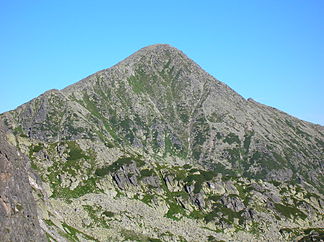Retezat Mountains
| Retezat Mountains | |
|---|---|
|
The Retezat Mountains in the west of the Carpathian Arc in Romania |
|
|
The eponymous summit, Vârful Retezat |
|
| Highest peak | Peleaga ( 2509 m ) |
| location | in the county of Hunedoara , Transylvania , Romania |
| Coordinates | 45 ° 22 ′ N , 22 ° 52 ′ E |
The Retezat Mountains ( Rum. Munții Retezat , Hungarian. Retyezát-hegység ) are the main mountain range of the Retezat-Godeanu Group, the westernmost part of the Southern Carpathians in Romania . Important parts of the mountains are under protection : it was declared the first Romanian national park in 1935 , which (along with Pirin and the Tatra National Parks in Poland and Slovakia ) is one of the most important high mountain nature reserves in Europe outside the Alps .
The Retezat National Park is located in the west of the massif, in the center of the mountain range, from an altitude of 794 m to the highest point of the mountain, the Peleaga summit at 2509 m . Another 19 peaks reach heights of over 2000 m , e.g. B. Păpușa ( 2508 m ), Retezat ( 2482 m ), Vârful Mare ( 2463 m ), Custura ( 2457 m ) and Bucura ( 2433 m ). The Lacul Bucura in the center of the massif is the largest natural lake in the Romanian Carpathians.
The area belongs to the Hunedoara district and thus still to the inner-Romanian Transylvania (Transylvania) . The surrounding valleys form a sharp contrast to the mountains, which are still characterized by very traditional mountain agriculture , as they are predominantly occupied by heavy industry . The region is a center of Romanian coal production . Around 60 percent of the working population work in the coal mines. Petroșani ( Eng . Petroschen - formerly also Steinthal ), east of the branching point of the valleys, is sometimes even called the city of coal . These coal deposits have long been known and in use (1788 - see Vulcan ). Some of the coal is used in the vicinity of the Retezat Mountains - for example in Vulcan ( Wolkersdorf ), Uricani or north of the mountains in Călan .
geography
The Retezat Mountains form the central massif of the western end of the Southern Carpathians, a final alpine peak from which the mountains drop to the west and south-west. To the east it is separated from the central part of the Southern Carpathians, the Șureanu-Parâng-Lotrului mountain range, by a deep cut . In detail, it is separated by the valley of the Strei ( Strell ) to the northeast from the Munții Șureanu and in the far east by the valley of the Jiu ( Schil ) from the Munții Parâng. These valleys form one of the three great breakthroughs or transitions of the Southern Carpathians between Transylvania and Wallachia . To the south you get to Little Wallachia .
In the south, the valley of Lupeni (pronounced: Lupèn, German Schylwolfsbach ), which runs in a west-east direction and the Retezat-Godeanu group drains centrally to the east, divides this mountain group - and the Retezat mountains from the Munții Vâlcan to the south. This valley branches off to the west at Petroșani from the Valea Jiului ( Schiltal ). It is the valley of the western Jiu source river, Jiul de Vest , which unites there with the eastern tributary - Jiul de Est , which rises between the eanerurean and Parâng mountains.
Mountains higher than 2000 m
|
geology
The main massif consists of crystalline slate and granite diorite . Only the so-called "Small Retezat" is a made of limestone existing karst massif .
tourism
The Retezat Mountains are - in relation to the national park - well developed for tourism, which can be seen from the numerous, well-marked hiking trails and the camping sites. Wild camping is prohibited. The paths are sometimes quite difficult to walk, as they often only consist of rough boulders.
Camping possibilities:
- Cabana Pietrele: located in the northern part, lots of mosquitoes, muddy, makes an overall impression of being neglected.
- Lacul Bucura (directly on the lake): wonderful view of the mountain panorama (Bucura, Peleaga, Judele). It can get tight there as there isn't too much space for the usually high number of visitors.
- Poiana Pelegii: lots of space, located in the valley, right next to a small stream.
- La Fete, at Cabana Buta: located directly on the stream; there are some good camping options.

literature
Jules Verne chose the area as the setting for his novel " The Carpathian Castle " (" Le Château des Carpathes ", 1892), in which mysterious and eerie events take place around a mountain castle - the one above a (fictional) place full of superstitious locals in the vicinity of the Retezat - turn out to be technical tricks. At the beginning, Verne emphasizes the legendary Transylvania (think of Dracula ) as the last refuge from riddles and adventures on the continent compared to other romantic regions of Europe , only to expose all sorcery as a fraud based on modern technology. He even mentions the industry in the valley (which appears far from the mountains). The French author also mentions the then fermenting Romanian national aspirations of the area that belonged to Hungary at the time .









